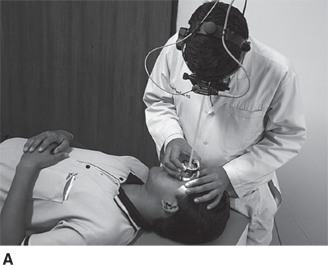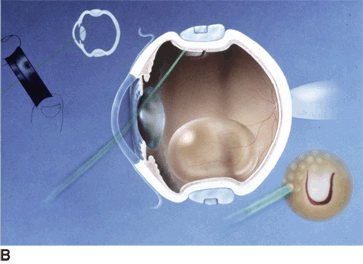Results: Photocoagulation prevented severe vision loss by 50% in PDR patients (at 4 years, 20% risk in treated eyes versus 44% risk in untreated eyes with HRC). The beneficial effect was seen in either xenon arc or laser modality. However, the xenon group showed more decreased visual acuity and constricted visual field. The DRS identified four retinopathy risk factors: (a) presence of new vessels, (b) new vessels on/within 1 disc diameter of the optic nerve (NVD), (c) NVD equal or greater than one fourth to one third disc area, or NVE (new vessels elsewhere) equal or greater than half disc area. (d) preretinal or vitreous hemorrhage.
Conclusions: Prompt photocoagulation prevents severe vision loss and is recommended in PDR eyes with HRC. Because of side effects, argon laser was recommended over xenon arc. The DRS identified four retinopathy risk factors for severe visual loss in eyes with PDR.

FIGURE 21.1. In this ultrawide angle fundus photograph, multiple laser scars from panretinal laser photocoagulation can be seen. The peripheral retina is largely ablated here, but efficacy of treatment may often be achieved by using less intense, less destructive laser lesions.
Early Treatment Diabetic Retinopathy Study
Similarly, treatment for diabetic macular edema was also established as efficacious. The Early Treatment Diabetic Retinopathy Study (ETDRS) established that focal photocoagulation for diabetic macular edema was effective in preventing visual loss, and the study provided guidelines for treatment including spot size, placement of applications, and ablation of microaneurysms.7 The results showed that such treatment not only reduced the risk of progressive visual loss but also increased the chance of visual recovery, and it was recommended that all eyes with clinically significant macular edema be at least considered for treatment as defined by the ETDRS protocol. It is important to note that this therapy was recommended for those eyes in which vision had not yet been affected but had impending macular involvement based on stereo fundus photography. Visual field loss was found to be minimal with focal photocoagulation (Box 21.2).
BOX 21.2 ETDRS: Early Treatment Diabetic Retinopathy Study
Purpose:
(a) Is focal photocoagulation beneficial in management of diabetic macular edema?
(b) When scatter photocoagulation should be initiated to be most effective in management of diabetic retinopathy?
(c) Is aspirin effective in altering the course of diabetic retinopathy?
Results:
(a) Focal photocoagulation reduced the risk of moderate vision loss by 50% in diabetic macular edema (12% risk in treated eyes vs. 24% risk in untreated eyes). The benefit was more apparent in patients with “clinically significant diabetic macular edema” (CSDME) (13% risk in treated eyes vs. 33% risk in untreated eyes).
(b) In severe and very severe NPDR, there is a much higher risk of progression to high-risk PDR (15% risk of developing high-risk characteristics, HRC at 1 year and 56% risk at 5 years in severe NPDR, and 45% risk at 1 year and 71% risk at 5 years in very severe NPDR).
(c) Aspirin did not have any effect on the progression to high-risk retinopathy, development of vitreous hemorrhage, or risk of visual loss.
Conclusions:
(a) The ETDRS recommended prompt focal laser photocoagulation in eyes with CSDME to prevent vision loss.
(b) Early photocoagulation should be considered in eyes with severe or very severe NPDR and in those with early PDR.
(c) There is no contraindication to aspirin use in NPDR or early PDR.
Panretinal photocoagulation is effective ostensibly by ablating the photoreceptors and deeper retinal layers in areas of ischemia, thereby decreasing the vascular endothelial growth factor (VEGF) load in the eye, which in turn induces involution of existing retinal neovascular fronds. For eyes with very advanced proliferative diabetic retinopathy and in eyes with tractional retinal detachment, the panretinal approach is much less effective.
As described in the preceding chapters, VEGF is a potent vasodilator and causes exudation as well as angiogenesis, or the growth of new blood vessels. Interestingly, panretinal photocoagulation may promote retinal edema, swelling, and inflammation, probably by promoting the additional release of VEGF in the areas of treatment, a consequence contrary to the theoretical goal of treatment. Indeed, marked edema is considered a potential complication of panretinal photocoagulation. On the other hand, when laser applications are performed in a less intense and gentler manner, efficacy can typically be achieved without inducing or exacerbating macular edema. Gentle panretinal treatment as a therapy controlled and titrated for the prevention of macular edema has been described.8 In experienced hands, panretinal photocoagulation seldom, if ever, exacerbates diabetic macular edema if the laser lesions are less intense. Use of indirect laser delivery systems can make the performance of panretinal laser photocoagulation much easier to achieve (Fig. 21.2).9,10 Furthermore, continued application of panretinal photocoagulation after a certain point is not in the patient’s best interest, as it creates night-vision difficulties and results in marked changes to the visual field. Severe loss of visual field can easily be demonstrated when patients have undergone confluent, intent panretinal photocoagulation. This approach, thus, does the patient a disservice and we need to improve our outcomes of this disease using alternatives.


FIGURE 21.2. Laser delivery via an indirect ophthalmoscopy and hand-held lens (A) facilitates rapid panretinal photocoagulation. No contact lens is used, (B) and topical anesthesia is all that is required for the procedure. Retrobulbar anesthesia is seldom necessary. The patient is typically much more comfortable using this method as compared to slit lamp systems where the patient’s position must be more rigid. (Courtesy of LV Prasad Eye Institute, Hyderabad, India.)
While the DRS and ETDRS were scientifically sound and pivotal in their scope, many clinicians unfortunately consider the laser treatment parameters used in the context of these studies as the only ones that have been proven, despite the fact that the investigators intended to establish efficacy, while the side effects of some treatments were not highlighted. Many have not modified their approach as technology has advanced and have assumed that laser treatment is a method where modifications and nuances do not matter. This leads to the belief that laser treatment implies a generic approach to retinal disorders despite the fact that careful selection of laser parameters is essential both to induce a therapeutic effect and to prevent avoidable complications.
With the advent of anti-VEGF approaches over the past several years, there has been a distinct shift away from laser photocoagulation as a primary treatment. Intravitreal injections, on the other hand, have been advocated or attempted for virtually all disease previously treated by retinal photocoagulation, except perhaps for the treatment of retinal tears or retinal detachment. In the wake of the success of anti-VEGF agents, laser treatment has waned in popularity much like the production of black and white movies, hardwired telephones, and print newspapers. To the lay public, the term “laser treatment” conjures up refractive surgery as they have much greater exposure to advertisements for LASIK and other procedures.
For wet macular degeneration, destructive laser photocoagulation was effective for limiting the overall extent of the neovascular lesion. The treatment effect, however, was preceded by an immediate reduction in visual acuity secondary to nonselective laser damage in the fovea. In essence, the patient traded off some of this immediate visual function for long-term security and gain by limiting the size of the central scotoma caused by a neovascular process. Side effects of retinal photocoagulation are multiple, but arguably, the most important are the creation of small central scotomata, difficulty fixating, and worsening of night vision due to disruption of the outer retina (Box 21.3). Later, verteporfin dye was introduced to make laser treatment for macular degeneration more tissue selective. The dye was administered intravenously after which the neovascular lesion was irradiated with a photosensitizing wavelength to induce localized tissue destruction. Verteporfin binds to lipoproteins and accumulates preferentially in areas of choroidal neovascularization. A 10-minute washout period is allowed for the dye to clear from the normal retinal vasculature. The laser energy by itself is not sufficient to cause denaturation of proteins or retinal photocoagulation. With dye present, occasionally retinal scarring and even frank photocoagulation may occur, though infrequently. In any case, the use of a pharmacologic agent for treatment became commonplace.
BOX 21.3 MPS: Macular Photocoagulation Study
Purpose: To examine whether direct laser photocoagulation of a choroidal neovascular membrane due to ARMD prevents vision loss as compared to observation alone.
Results:
(a) Extrafoveal CNV Study: At 6 months, severe vision loss was reduced significantly by laser treatment (25% risk in treated eyes vs. 60% risk in untreated eyes). There was recurrence of CNV in 54% treated eyes after 5 years.
(b) Juxtafoveal Krypton Laser Study: At 3 years, severe vision loss was reduced by laser treatment, and the benefit was high in normotensive patients (49% risk in treated eyes vs. 58% risk in untreated eyes).
(c) Subfoveal Argon or Krypton Laser Study: Although there was an immediate severe vision loss in treated eyes, long-term results showed a more stable vision. At 4 years, severe vision loss was seen in 22% of treated eyes versus 47% of untreated eyes.
(d) Recurrent Subfoveal CNV Study: At 3 years, severe vision loss occurred in 12% of treated eyes versus 36% of untreated eyes.
Conclusions: Direct laser treatment of choroidal neovascular membrane prevented severe vision loss, and the benefit was most apparent in extrafoveal lesions. Only a small percentage of patients with neovascular ARMD qualified for laser treatment as laser was indicated for an angiographically well-defined membrane.
Stay updated, free articles. Join our Telegram channel

Full access? Get Clinical Tree


